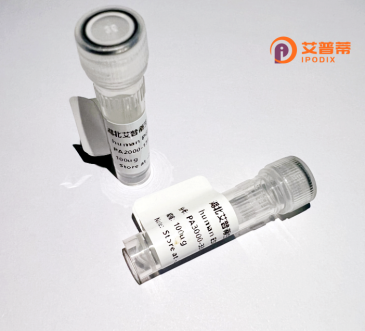
| 纯度 | >90%SDS-PAGE. |
| 种属 | Human |
| 靶点 | ZFP36L2 |
| Uniprot No | P47974 |
| 内毒素 | < 0.01EU/μg |
| 表达宿主 | E.coli |
| 表达区间 | 1-497 aa |
| 活性数据 | MSTTLLSAFYDVDFLCKTEKSLANLNLNNMLDKKAVGTPVAAAPSSGFAPGFLRRHSASNLHALAHPAPSPGSCSPKFPGAANGSSCGSAAAGGPTSYGTLKEPSGGGGTALLNKENKFRDRSFSENGDRSQHLLHLQQQQKGGGGSQINSTRYKTELCRPFEESGTCKYGEKCQFAHGFHELRSLTRHPKYKTELCRTFHTIGFCPYGPRCHFIHNADERRPAPSGGASGDLRAFGTRDALHLGFPREPRPKLHHSLSFSGFPSGHHQPPGGLESPLLLDSPTSRTPPPPSCSSASSCSSSASSCSSASAASTPSGAPTCCASAAAAAAAALLYGTGGAEDLLAPGAPCAACSSASCANNAFAFGPELSSLITPLAIQTHNFAAVAAAAYYRSQQQQQQQQQQGLAPPAQPPAPPSATLPAGAAAPPSPPFSFQLPRRLSDSPVFDAPPSPPDSLSDRDSYLSGSLSSGSLSGSESPSLDPGRRLPIFSRLSISDD |
| 分子量 | 77.8 kDa |
| 蛋白标签 | GST-tag at N-terminal |
| 缓冲液 | PBS, pH7.4, containing 0.01% SKL, 1mM DTT, 5% Trehalose and Proclin300. |
| 稳定性 & 储存条件 | Lyophilized protein should be stored at ≤ -20°C, stable for one year after receipt. Reconstituted protein solution can be stored at 2-8°C for 2-7 days. Aliquots of reconstituted samples are stable at ≤ -20°C for 3 months. |
| 复溶 | Always centrifuge tubes before opening.Do not mix by vortex or pipetting. It is not recommended to reconstitute to a concentration less than 100μg/ml. Dissolve the lyophilized protein in distilled water. Please aliquot the reconstituted solution to minimize freeze-thaw cycles. |
1. **"Regulation of the RNA-binding protein ZFP36L2 during activation and differentiation of mammalian B cells"**
- 作者:Sommer G 等
- 摘要:研究ZFP36L2在B细胞活化和分化中的调控功能,发现其通过结合特定mRNA的3'非翻译区(ARE元件)促进靶标RNA降解,调控B细胞周期进程及抗体分泌。
2. **"ZFP36L2 is required for self-renewal of early burst-forming unit erythroid progenitors"**
- 作者:Bogdanovic O 等
- 摘要:揭示ZFP36L2在胚胎红系祖细胞增殖中的作用,重组蛋白实验表明其通过抑制促凋亡基因mRNA稳定性维持红细胞前体细胞的自我更新能力。
3. **"Structural and functional analysis of the phosphorylation-dependent interaction between AUF1 and ZFP36L2"**
- 作者:Hudson BP 等
- 摘要:利用重组ZFP36L2蛋白研究其与AUF1的磷酸化依赖性结合机制,阐明该互作如何协同调控炎症相关mRNA的稳定性及翻译效率。
4. **"ZFP36L2 suppresses mTORC1 and promotes differentiation in keratinocytes by targeting DEPTOR mRNA"**
- 作者:Dassi E 等
- 摘要:证明重组ZFP36L2通过降解DEPTOR mRNA抑制mTORC1信号通路,调控皮肤角质形成细胞的分化,为治疗增生性皮肤病提供分子机制依据。
ZFP36L2 (zinc finger protein 36-like 2), also known as BRF2 or TIS11D, is a member of the TIS11 family of RNA-binding proteins. It plays a critical role in post-transcriptional gene regulation by binding to AU-rich elements (AREs) in the 3'-untranslated regions (3'-UTRs) of target mRNAs, promoting their deadenylation and degradation. Structurally, it contains a conserved CCCH-type zinc finger domain essential for RNA interaction.
First identified in the 1990s, ZFP36L2 is involved in diverse cellular processes, including cell cycle progression, apoptosis, and immune response modulation. Studies highlight its role in maintaining genomic stability by regulating transcripts associated with DNA replication and repair. In immunity, it controls cytokine and chemokine mRNA stability, influencing inflammatory pathways.
Dysregulation of ZFP36L2 is linked to diseases such as cancer, where its loss or mutation correlates with tumor progression and metastasis. For example, reduced ZFP36L2 expression in B-cell malignancies allows survival of abnormal cells. It also impacts female fertility by regulating maternal mRNA stability during oocyte development.
Recent research explores its therapeutic potential, particularly in targeting inflammation-related disorders and cancers. Its mRNA-binding specificity and role as a tumor suppressor make it a promising focus for RNA-centric therapies. However, mechanistic details of its target selectivity and tissue-specific functions remain areas of active investigation.
×